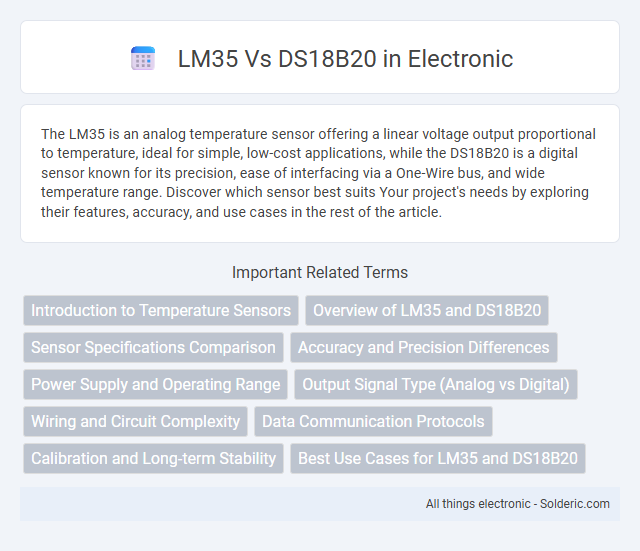The LM35 is an analog temperature sensor offering a linear voltage output proportional to temperature, ideal for simple, low-cost applications, while the DS18B20 is a digital sensor known for its precision, ease of interfacing via a One-Wire bus, and wide temperature range. Discover which sensor best suits Your project's needs by exploring their features, accuracy, and use cases in the rest of the article.
Comparison Table
| Feature | LM35 | DS18B20 |
|---|---|---|
| Sensor Type | Analog temperature sensor | Digital temperature sensor |
| Temperature Range | -55degC to 150degC | -55degC to 125degC |
| Accuracy | +-0.5degC at 25degC | +-0.5degC from -10degC to 85degC |
| Output | Voltage proportional to temperature (10mV/degC) | Digital (1-Wire Protocol) |
| Interface | Analog input | 1-Wire digital bus |
| Power Supply | 4V to 30V | 3V to 5.5V |
| Unique ID | No | Yes (64-bit serial code) |
| Applications | Simple temperature measurement, analog circuits | Multiple sensor networks, precise digital readings |
| Cost | Low | Moderate |
Introduction to Temperature Sensors
Temperature sensors like the LM35 and DS18B20 play a crucial role in measuring environmental conditions with precision. The LM35 provides an analog output voltage proportional to temperature, making it suitable for straightforward, real-time temperature monitoring in various electronics projects. Your choice between these sensors depends on the required accuracy, interface type, and operating environment since the DS18B20 offers digital output and unique identification for complex, multi-sensor networks.
Overview of LM35 and DS18B20
The LM35 is an analog temperature sensor providing a voltage output linearly proportional to Celsius temperature, with a typical accuracy of +-0.5degC and operating voltage ranging from 4V to 30V. The DS18B20 is a digital temperature sensor using a 1-Wire interface, delivering 9 to 12-bit temperature readings with accuracy of +-0.5degC over a wide temperature range from -55degC to +125degC. Both sensors are widely used in temperature measurement but differ in output type, communication protocol, and power requirements, making the DS18B20 more suitable for digital systems requiring precise digital data and easy multi-drop wiring.
Sensor Specifications Comparison
The LM35 temperature sensor offers a linear output voltage directly proportional to Celsius temperature, with a typical accuracy of +-0.5degC and a measurement range from -55degC to 150degC. The DS18B20, a digital sensor with a 12-bit resolution, provides temperature readings from -55degC to 125degC with +-0.5degC accuracy over the central range and features a 1-Wire interface for easy integration and multiple sensor networking. Your choice between LM35 and DS18B20 depends on whether you require analog output for simple circuit designs or precise digital communication with enhanced noise immunity.
Accuracy and Precision Differences
The LM35 sensor offers an accuracy of +-0.5degC at room temperature, making it suitable for general temperature measurements, while the DS18B20 provides a higher accuracy of +-0.5degC across a broader range with digital precision. The DS18B20's 12-bit resolution allows for finer temperature readings compared to the LM35's analog output, which may suffer from noise and calibration drift. If your project demands precise and reliable temperature data, especially in digitally controlled systems, the DS18B20 is the more accurate and precise choice.
Power Supply and Operating Range
The LM35 temperature sensor operates on a power supply range of 4 to 30 volts with an operating temperature range from -55degC to 150degC, making it suitable for wide voltage applications. The DS18B20 requires a 3V to 5.5V power supply and functions accurately within -55degC to 125degC, often preferred for digital precision in narrow voltage environments. Choosing between these sensors depends on your system's voltage constraints and temperature measurement requirements.
Output Signal Type (Analog vs Digital)
The LM35 temperature sensor provides an analog voltage output proportional to temperature, requiring an analog-to-digital converter (ADC) for digital systems. The DS18B20 features a digital output with a 1-Wire interface, delivering temperature data directly as a digital signal without the need for ADC. You should choose LM35 if your system supports analog inputs, whereas DS18B20 simplifies integration with microcontrollers that handle digital communication.
Wiring and Circuit Complexity
The LM35 sensor features a simple three-pin configuration requiring just power, ground, and analog output, making its wiring straightforward and ideal for basic temperature measurement circuits. In contrast, the DS18B20 uses a one-wire interface that reduces the number of data lines needed but may require a pull-up resistor, adding slight complexity to the circuit design. Your choice depends on whether you prioritize ease of wiring with LM35 or the digital communication advantages offered by DS18B20.
Data Communication Protocols
LM35 uses an analog voltage output proportional to temperature, requiring an analog-to-digital converter (ADC) in your microcontroller for data reading. DS18B20 employs the 1-Wire digital communication protocol, allowing multiple sensors to connect on a single data line with unique addresses. Choosing between them depends on your project's need for simplicity (LM35) or digital accuracy and multi-sensor support (DS18B20).
Calibration and Long-term Stability
The LM35 temperature sensor offers excellent linearity and requires minimal calibration efforts, but its accuracy can drift over time due to aging and environmental factors. The DS18B20 provides digital output with built-in calibration and maintains stable accuracy over prolonged periods, making it more reliable for long-term applications. For precise temperature monitoring, DS18B20's inherent calibration and long-term stability often outperform the analog LM35 sensor.
Best Use Cases for LM35 and DS18B20
LM35 excels in analog temperature sensing with precise linear voltage output, making it ideal for applications requiring real-time temperature monitoring and simple circuit integration, such as HVAC systems and automotive sensors. DS18B20 is perfect for digital temperature measurements with high accuracy and unique 1-Wire interface support, fitting well in remote temperature sensing, weather stations, and home automation projects. Your choice depends on whether you need analog signal compatibility (LM35) or digital communication with multiple sensor management (DS18B20).
LM35 vs DS18B20 Infographic

 solderic.com
solderic.com